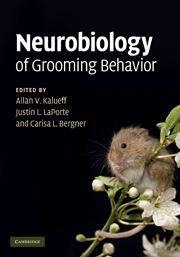Book contents
- Frontmatter
- Contents
- List of contributors
- Preface
- 1 Grooming, sequencing, and beyond: how it all began
- 2 Self-grooming as a form of olfactory communication in meadow voles and prairie voles (Microtus spp.)
- 3 Phenotyping and genetics of rodent grooming and barbering: utility for experimental neuroscience research
- 4 Social play, social grooming, and the regulation of social relationships
- 5 Grooming syntax as a sensitive measure of the effects of subchronic PCP treatment in rats
- 6 Modulatory effects of estrogens on grooming and related behaviors
- 7 Lack of barbering behavior in the phospholipase Cβ1 mutant mouse: a model animal for schizophrenia
- 8 Grooming after cerebellar, basal ganglia, and neocortical lesions
- 9 Striatal implementation of action sequences and more: grooming chains, inhibitory gating, and the relative reward effect
- 10 An ethological analysis of barbering behavior
- 11 Should there be a category: “grooming disorders?”
- 12 Neurobiology of trichotillomania
- Index
- References
4 - Social play, social grooming, and the regulation of social relationships
Published online by Cambridge University Press: 04 August 2010
- Frontmatter
- Contents
- List of contributors
- Preface
- 1 Grooming, sequencing, and beyond: how it all began
- 2 Self-grooming as a form of olfactory communication in meadow voles and prairie voles (Microtus spp.)
- 3 Phenotyping and genetics of rodent grooming and barbering: utility for experimental neuroscience research
- 4 Social play, social grooming, and the regulation of social relationships
- 5 Grooming syntax as a sensitive measure of the effects of subchronic PCP treatment in rats
- 6 Modulatory effects of estrogens on grooming and related behaviors
- 7 Lack of barbering behavior in the phospholipase Cβ1 mutant mouse: a model animal for schizophrenia
- 8 Grooming after cerebellar, basal ganglia, and neocortical lesions
- 9 Striatal implementation of action sequences and more: grooming chains, inhibitory gating, and the relative reward effect
- 10 An ethological analysis of barbering behavior
- 11 Should there be a category: “grooming disorders?”
- 12 Neurobiology of trichotillomania
- Index
- References
Summary
Summary
Social grooming and rough-and-tumble play, along with caressing and hand-shaking, have something important in common, touching. Physical contact with another can be an essential ingredient of social communication – gentle touching can place the other animal at ease, whereas rough contact can do the opposite. Although the underlying neurobiology is still to be fully mapped, it does appear that there is a common set of neurochemical pathways that regulate these touch-induced changes in mood across mammals. Given its potential value in the manipulation of the affective state of social partners, it should not be surprising that touch is an important component of communication. A close analysis of the comparative and neurobiological literature on rough-and-tumble play, or play fighting, suggests that there are two levels of control over this touch-based communication. Firstly, there is the subcortically regulated emotional state of the interactants. Secondly, there is the cortically mediated modulation of the touching behavior that allows animals to use touch in a more strategic manner. How these two levels interact and what social conditions foster the need for additional cortical control over touch remains to be determined.
Introduction
A hostile donkey is rendered peaceful by the human object of its ire vigorously rubbing the base of its tail (Ewer 1967), an anxious monkey is calmed down after being groomed by a social partner (Goosen 1981), and agitated rats relax after social play (Arelis 2006; Darwish et al. 2001). What do all these situations have in common?
- Type
- Chapter
- Information
- Neurobiology of Grooming Behavior , pp. 66 - 87Publisher: Cambridge University PressPrint publication year: 2010
References
- 6
- Cited by



